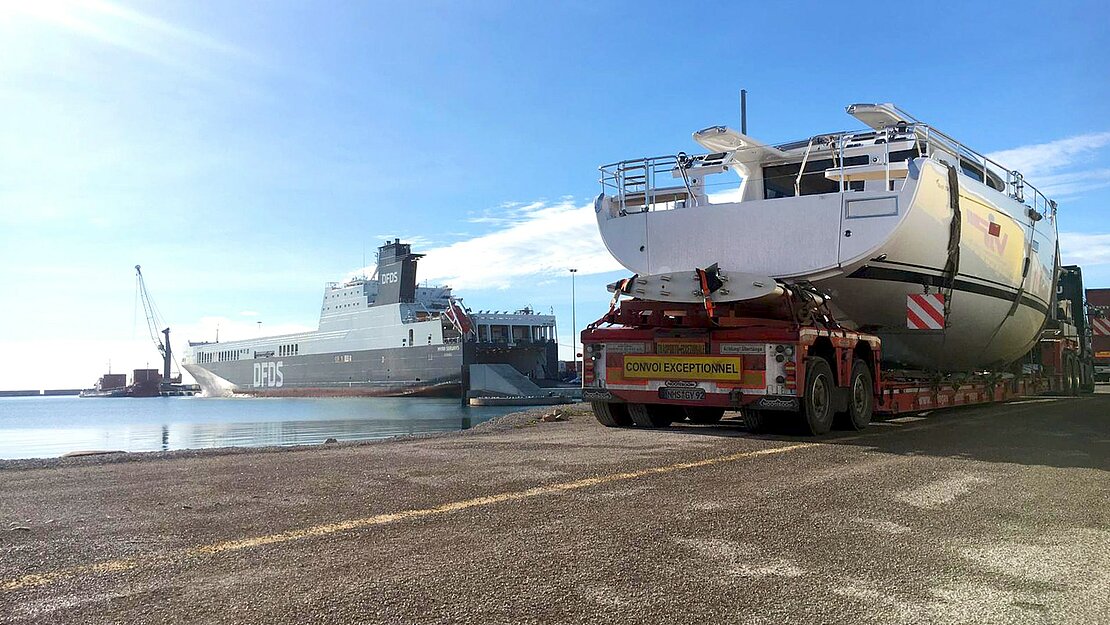How do our Moody sailing yachts find their way to their new owners? Depending on the destination and the chosen delivery method, our sailboats get to their new home in different ways. Each yacht transport holds special challenges. We show the three most important delivery routes of the yacht transfer with their special features.
Yacht handover in Greifswald
Taking over their new yacht is a special event for many owners. That is why a lot of sailors personally take delivery of their new sailboat in Greifswald, Germany. The shipyard's own delivery pier on the river Ryck with its direct access to the Baltic Sea offers the best starting conditions for this. In addition to a detour through the historic Hanseatic city, there is also the opportunity to test the yacht on the Bay of Greifswald with the dealer, to carry out the inspection personally and to realise additional equipment wishes, e.g., solar cells, underwater painting or stainless steel work with the specialised companies on site. Greifswald is also a so-called “port of entry” – all in- and outward clearance can be carried out via the Wolgast customs office.
For transfers on the water from Greifswald to a distant port, a transfer crew or an experienced skipper is usually available.
Road transfer by truck
If personal collection in northern Germany is out of the question, our experienced partners will deliver the yacht to your dealer or directly to its home port. Specially equipped trucks and specialised transport companies are then used. For safe road transport, certain parts of the yacht such as the rigging, keel or rudder blade are dismantled in the shipyard and stowed separately before loading. To avoid staining during delivery, the boat can be shrink-wrapped on request in the shipyard. Due to the excess length, the convoy often starts at night for the transfer journey.
A yacht transport by road means above all planning work: in addition to the exact route planning, permits have to be obtained from local authorities, as the trucks used are considered heavy goods vehicles – no wonder, as the loaded cargo can weigh more than 40 tons in total and be up to 24 metres long. If the truck passes an international border, customs papers must be filled out. On many roads, an escort vehicle of the category 3, 4 or the police is also mandatory. On the way, numerous challenges await: often very narrow, winding or steep roads as well as low bridges and difficult weather conditions have to be overcome without damaging the valuable cargo.
Transfer overseas by cargo ship
Often, the future home port cannot be reached by land. The transporter's destination is then the nearest overseas port, for example Bremerhaven in Germany. Frequently chosen destinations are Baltimore, Newport, or Palm Beach in the United States. As the sailing yachts are loaded onto the deck of the cargo ship, there is also the option of delivering the yacht waterside and loading it with a standing mast and mounted keel, in addition to delivery by truck. In this case, the backstay must be detached for the loading and unloading process. On the deck of the freighter, the yacht is securely fixed against swell and placed on a specially designed scaffold to keep it in position during the voyage. Then it is off on a transfer voyage lasting several days all over the world. From Europe to North America, for example, the voyage takes two to three weeks. In addition to the usual challenges that are inevitable on a sea voyage due to wind and waves, customs regulations, entry requirements and onward transport from the cargo port must of course be arranged in advance.
Once they have arrived at their destination, our dealers, or the owners themselves, take over the sailing yacht and take care of the onward transport to the port of destination. There, the yacht is handed over to its new owners and, if desired, a test sail is made on the respective waters.
No matter what you decide: Your yacht is in the best hands with our partners and will arrive safely in her new home port thanks to experienced personnel and highly specialised transport vehicles. Talk to your dealer about the delivery route that suits you best.
Back to overview

